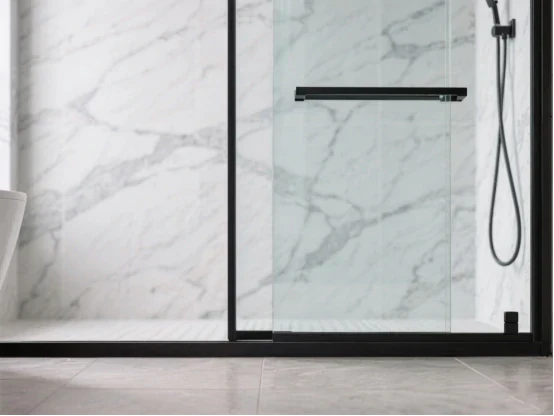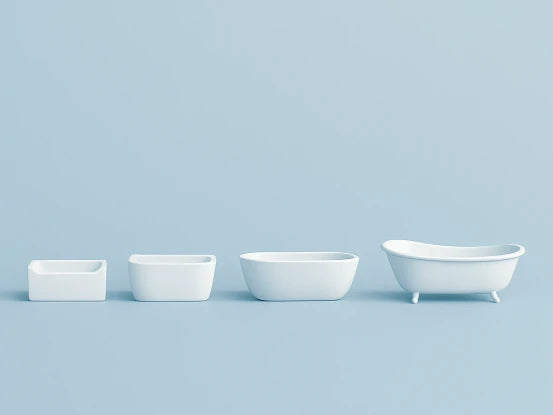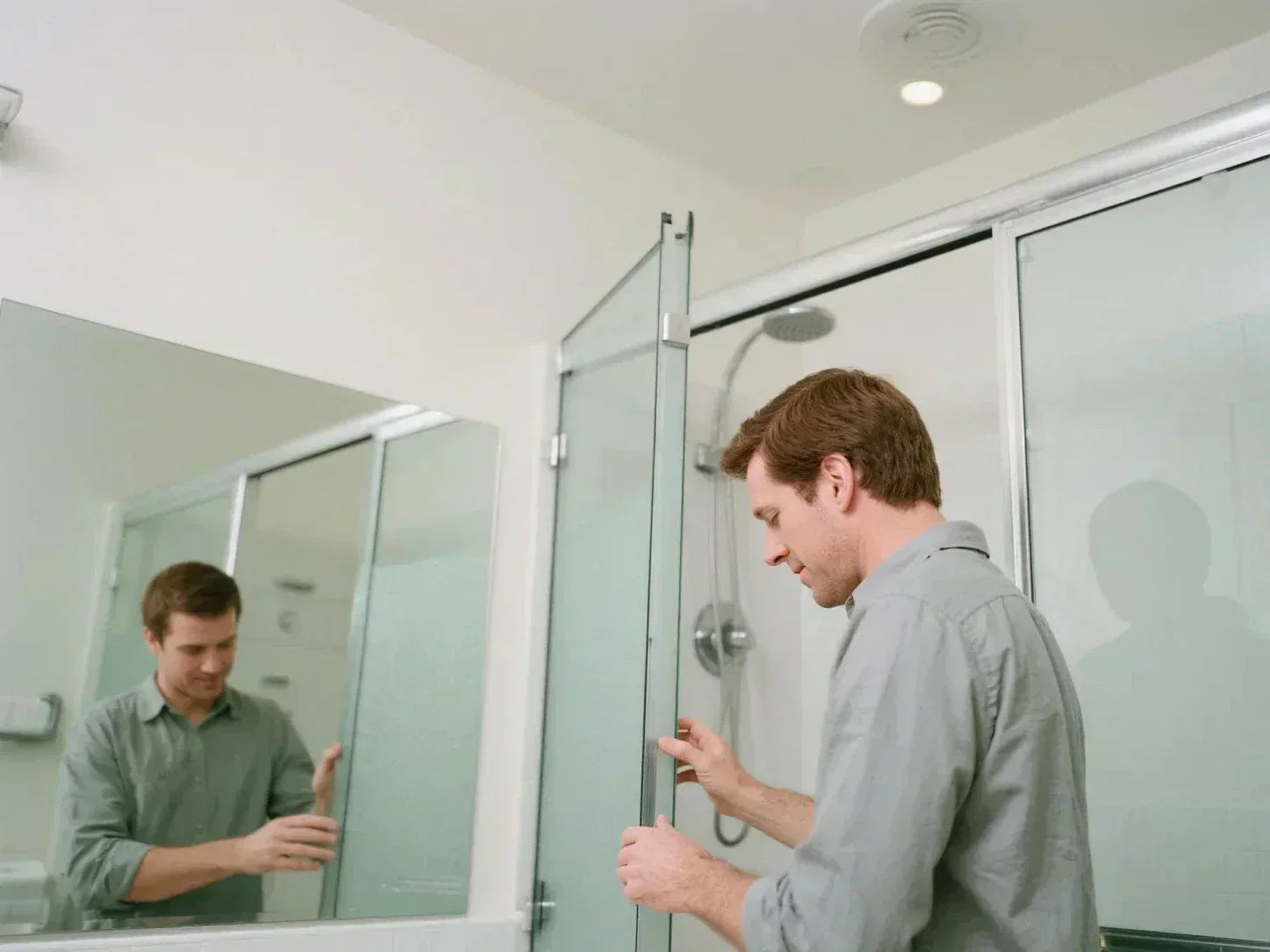A sliding shower door is a top choice for anyone looking to upgrade their bathroom. Often called a bypass door, this popular fixture offers a sleek look, saves precious floor space, and provides simple functionality. Whether you're remodeling an existing space or planning a new one, this guide will walk you through everything you need to know. We will cover the benefits, different types, installation tips, and how they compare to a hinged door, helping you make the perfect choice for your home.
Sliding Shower Door Overview & Quick Comparison
So, what exactly makes a sliding shower door so appealing? Let's break down the basics and see how it stacks up against other options, such as framed shower doors.
What Is a Sliding Shower Door?
A sliding door for a shower consists of two or more glass panels that glide horizontally along a track. One panel typically slides behind the other, providing access to the shower enclosure or tub. Unlike doors that swing open, these doors slide smoothly parallel to the wall, making them a smart solution for almost any bathroom layout.
Why Choose One?
The decision to install a sliding glass door often comes down to five key advantages that make it a preferred choice for modern bathrooms:
Space Efficiency: Sliding shower doors are uniquely suited for bathrooms where every inch counts. Unlike hinged doors that swing outward and require clearance space, sliding doors glide along a track and remain flush with the shower enclosure. This allows homeowners to maximize floor space and avoid design conflicts with nearby fixtures such as vanities, toilets, or towel bars. In compact bathrooms, this efficiency can make the difference between a cramped layout and a functional, open space. It also makes sliding doors a smart choice for layouts with limited clearance or awkward angles.
Modern Aesthetics: The sleek, horizontal movement of a sliding glass door contributes to a clean and streamlined visual impact. Whether framed or frameless, these doors offer a contemporary feel that enhances both small and large bathrooms, making them a pro choice for any renovation. Frameless sliding doors in particular bring a minimalist appeal, highlighting the beauty of tile work and allowing light to pass through unobstructed, which can make a bathroom feel brighter and more expansive. On the other hand, framed sliding doors provide a touch of classic elegance and come in various finishes, from polished chrome to matte black, to complement a wide range of design themes.
Versatile Use: Sliding glass doors are remarkably adaptable, making them a practical option for various shower types. They are commonly installed over bathtubs, providing a seamless water barrier without the need for a curtain, and they also work exceptionally well in walk-in showers, especially those with wide or rectangular openings. Their smooth operation and stable track system make them ideal for daily use, while optional features like soft-close mechanisms and dual sliding panels enhance both convenience and accessibility. Whether you are remodeling a master suite or updating a guest bath, sliding shower doors offer a versatile solution that balances form and function.
Ease of Maintenance: Compared to hinged doors, sliding shower doors often feature simpler components that are easier to clean and maintain. Many models include quick-release rollers or removable tracks, allowing for more thorough cleaning without specialized tools. Frameless sliding doors reduce the number of metal edges and corners where soap scum and mildew tend to accumulate. With regular upkeep, these doors retain their clarity and function for years, offering long-term performance with minimal hassle.
Enhanced Safety and Stability: Sliding doors operate on a track, which adds a level of stability and safety—particularly for households with children or older adults. Because the doors don’t swing outward, there is less risk of hitting nearby objects or people. Many high-quality models use tempered safety glass and come with smooth-glide technology that prevents sudden slamming. For added security, some systems offer anti-jump mechanisms that keep the doors securely on track, reducing the risk of accidents and ensuring consistent operation.
Quick Comparison: Sliding vs. Hinged Shower Doors
Choosing between sliding and hinged shower doors is a common dilemma. Here is a quick table to help you compare the two.
| Feature | Sliding Shower Door | Hinged Shower Door |
|---|---|---|
| Space Efficiency | Excellent. No out-swing space is needed. | Requires floor clearance. The door to swing open needs empty space. |
| Aesthetics | Sleek, modern look. Great for contemporary styles. | Classic or traditional. Can feel more like a standard room door. |
| Cleaning | The bottom track can collect water and soap scum. | No track, but the hinge area can be tricky to clean. |
| Accessibility | Moderate. The entry width is limited by the panel overlap. | Wider entry. Often better for people with mobility issues. |
| Variety | Many styles, glass types, and hardware options. | Fewer customizations available for the opening mechanism. |
Types of Sliding Shower Doors
Once you've decided on a sliding door, you'll find a surprising number of options. Let's explore the main styles and configurations available.
Framed, Semi-Frameless, and Frameless
The frame is one of the biggest visual differentiators when choosing shower doors.

Framed Doors: These are the most traditional and often most affordable option. The metal frame supports thinner glass panels and creates a very sturdy shower enclosure. The frame can feel a bit bulky, but it provides a strong watertight seal.
Semi-Frameless Doors: A popular middle ground, these doors have fewer metal components. Typically, the main frame around the opening is present, but the individual glass doors themselves are unframed, creating a more open feeling.
Frameless Sliding Doors: For a truly minimalist and luxurious look, frameless doors offer a seamless view. They use thicker, heavier tempered glass and minimal hardware, like exposed rollers at the top. Frameless glass shower doors make a small bathroom feel larger and brighter. And yes, you can absolutely have a frameless sliding shower door; it's one of the most sought-after styles today.
Configurations & Designs
Beyond the frame, the way the doors slide along a track can vary.
Bypass/Two-Panel: This is the classic design where both glass panels that slide can move, allowing you to enter from either side of the shower.
Barn-Door Style: This trendy design features one large glass door that glides on an exposed overhead roller system, similar to a rustic barn door. The other panel is a fixed glass panel.
Corner Entry: Ideal for corner showers, this design features two sliding doors that meet at the corner, opening inward to save space in the main bathroom area.
Custom Options: You can personalize your glass shower door with different finishes and glass types. Options include frosted glass for privacy, tinted glass for a unique look, or etched patterns for a decorative touch. You can also choose from various handle styles and hardware finishes like matte black, brushed nickel, or chrome.
How to Choose the Best Sliding Shower Door for You?
Finding the right shower door is about more than just looking. It requires careful planning and measurement to ensure a perfect fit and long-lasting performance.
Space & Fit
Getting the measurements right is the most critical step for installing a shower door for your bathroom. A mistake here can lead to a leak or a door that doesn't operate correctly.
Measure the Width: Measure the opening width at the top, middle, and bottom of the shower threshold. If the measurements differ, use the largest one and be prepared to make adjustments.
Measure the Height: Measure the distance from the shower threshold to the top of the tile or shower surround. Make sure you have enough wall height for the door assembly.
Check for Plumb: Use a level to check if your walls are perfectly vertical (plumb). If they are not, you may need a door model that allows for some adjustability or consider a professional installation.
For anyone with mobility issues, look for a sliding door with a low-profile bottom track to make it easier to step into the shower. Also check local building codes for any specific accessibility requirements.
Style & Materials
The materials you choose will affect both the look and durability of your door.
Glass Thickness: Tempered glass is a safety standard for shower doors. Thickness typically ranges from 1/4-inch (6mm) to 3/8-inch (10mm). Thicker glass is heavier, feels more luxurious, and is essential for frameless sliding doors.
Glass Treatments: Many shower doors come with a factory-applied coating that repels water and oil. This makes easy cleaning and maintenance a reality, as it helps prevent stains and soap scum buildup.
Checklist Before Buying
Are you ready to make a choice? Ask yourself these questions before you buy:
- Is my shower opening a standard size, or will I need a custom door?
- Do I want frameless, semi-frameless, or framed doors?
- What hardware finish (chrome, nickel, black) best matches my other bathroom fixtures?
- Do I need extra features like a built-in towel bar for my frameless single sliding shower door in the barn door shower doors?
- Have I checked my local building codes for any specific tempered glass or safety regulations?
Sliding Shower Door Cost, Value, and ROI
A new glass sliding shower is an investment. The cost can vary widely based on the style, materials, and whether you install it yourself.
Budget Tier: Basic, framed doors can start at around $250 to $500. These are often made with thinner glass and standard hardware.
Mid-Range Tier: Semi-frameless and some frameless doors offer a great balance of style and cost, typically ranging from $500 to $1,000.
Luxury Tier: High-end, custom frameless sliding doors with thick glass and premium hardware can cost $1,500 or more.
While it's an upfront cost, a high-quality sliding shower door can significantly increase your home's perceived value. It's a modern update that makes a bathroom feel more luxurious and functional—a, a great return on investment for most renovations. Professional installation can add several hundred dollars to the cost, but for many homeowners, the peace of mind that comes with proper installation is worth it when considering the benefits of sliding shower doors in maximizing space.
Sliding Shower Door Installation (Step-by-Step)
For the confident DIY homeowner, installing a sliding shower door is a manageable weekend project. Precise installation is key to preventing a future leak.
Gather Your Tools: Before you start, make sure you have everything you need. This usually includes a hacksaw (for cutting the tracks), a drill with various bits, a level, a tape measure, a caulking gun with silicone sealant, and a set of screwdrivers.
Prep the Opening: Unpack your new door and check that all parts are included for the installation of durable sliding shower doors. Carefully re-measure your opening and compare it to the manufacturer's specifications. Now is the time to catch any discrepancies.
Install Tracks and Headers: Mark a centerline on your shower threshold. This will guide where you place the bottom track. Cut the track to size with a hacksaw. Drill pilot holes and secure it in place. Do the same for the vertical side jambs and the top header track, using your level constantly to ensure the installation of semi-frameless sliding shower doors is precise.
Hang the Glass Panels Safely: This is a two-person job. Glass panels are heavy and fragile. Carefully lift the panels and hang them on the roller systems in the top track. The inner door (the one closest to the showerhead) should be installed first.
Seal Edges and Test Operation: Once the doors are hanging, install any required gaskets or sweeps to create a watertight seal. Test the doors to make sure they slide along a track smoothly without dragging. Finally, apply a bead of 100% silicone caulk along the inside and outside edges of the frame where it meets the walls and threshold. Do not apply caulk to the inside of the shower along the bottom track, as it has weep holes designed to drain water.

Common Pitfalls to Avoid
Out-of-Level Threshold: If your base isn't level, the doors may not hang correctly, causing them to drag or leave gaps.
Skipping the Sealant: Failing to properly caulk all seams is the number one cause of a leak.
Over-Tightening Hardware: This can crack the tile or the glass door itself. Tighten fasteners until they are snug, but don't use excessive force.
Maintenance, Cleaning, and Longevity
Are sliding shower doors any good over the long term? Yes, with regular maintenance, they can last for 10 to 15 years. The key is proper care.

Routine Cleaning
One of the main disadvantages of a sliding shower door can be the door's track. The overlapping panels and the bottom track can be areas where soap scum and grime collect.
Squeegee After Every Use: This is the single best thing you can do. Wiping down the glass after each shower prevents mineral and soap buildup.
Use Non-Abrasive Cleaners: A simple solution of vinegar and water often works best. Avoid harsh chemicals that can damage the stainless steel hardware finish or the glass coating.
Clean the Tracks: Use an old toothbrush or a crevice tool to regularly clear debris from the bottom track. This ensures the doors slide smoothly and prevents buildup.
Long-Term Upkeep
Over time, parts can wear out. Periodically inspect the following:
Rollers: Check to see if the rollers are worn or cracked. Replacements are often available from the manufacturer.
Seals and Sweeps: The vinyl seals along the edges of the doors may become brittle or discolored. Replacing them is an inexpensive way to prevent leaks and keep your frameless shower doors looking great.
Caulk: If you notice any peeling or moldy caulk, scrape it away and apply a fresh bead.
Preventing Common Issues
Leaks: Proper installation is the best prevention. If a leak develops, check your seals and caulk lines first. A watertight seal is essential.
Sticking Doors: This is almost always caused by dirty rollers or a clogged bottom track. A thorough cleaning usually solves the problem.
Modern Design Inspiration
A sliding shower door can be a stunning focal point in your bathroom. They are no longer just a practical choice; they are a design statement.
Small Bathroom Savior: Frameless sliding doors are perfect for small bathrooms. By eliminating visual clutter, they make the entire room feel more open and airy. Pairing an ultra-clear glass door with light-colored tile creates a feeling of spaciousness.
Dramatic Hardware: Consider hardware that contrasts with your tile. Matte black hardware, for example, creates a bold, industrial look that is very popular. Brushed gold or nickel can add a touch of warmth and luxury.
Get the Look: Look at online galleries or design magazines for inspiration. See how other homeowners have used a glass sliding shower in a space similar to yours, sliding shower doors use innovative designs to maximize space efficiency. A door can enhance the entire aesthetic of a room when chosen thoughtfully.
Additional Resources
For specific regulations and requirements, it's always best to consult authoritative sources.
Building Codes: Your local municipality's website is the best place to find information on building codes, permits, and safety glass requirements in your area.
Safety Standards: The International Code Council (ICC) develops model codes used by many local governments. Their resources can provide general guidance on construction and safety standards.
Conclusion
Upgrading to a sliding shower door is a fantastic way to blend style and functionality in your bathroom. These doors provide a modern, space-efficient solution that works equally well for a large walk-in shower or a compact tub. With a clear understanding of the different types, installation steps, and maintenance needs, you can confidently choose the right glass shower door for your home. Given their durability and timeless appeal, the sliding shower door will remain a smart and beautiful choice for years to come.
Sliding Shower Door: Frequently Asked Questions
1. Do sliding glass shower doors leak?
A sliding shower door should not leak when properly installed and maintained. The majority of leaks stem from either a failed seal or improper caulking during the installation process. The best way to keep your shower enclosure dry is through regular maintenance of the seals and caulk lines.
2. Are sliding shower doors harder to clean?
The overlapping panels and bottom track create potential cleaning challenges for these types of doors. This is a well-known disadvantage. Modern door designs include quick-release bottom mechanisms which provide easy cleaning access. Daily squeegee use significantly decreases the amount of cleaning work required.
3. Can you have a frameless sliding shower door?
Absolutely. The modern aesthetic of frameless sliding doors makes them extremely popular among consumers. The doors use thick tempered glass and heavy-duty top rollers to provide an unobstructed view.
4. What is better, a sliding or hinged shower door?
The best choice depends on your bathroom layout and personal needs. Hinged doors require sufficient space to swing open but this space may not always be available. Sliding doors are ideal for bathrooms with limited space. Hinged shower doors offer a larger opening than sliding doors which makes them more suitable for people who need wider access.
5. Are sliding shower doors any good?
They are an excellent and popular choice. They offer a dependable, compact, and fashionable answer for most shower and tub enclosures. High-quality options exist for every budget and design preference because there are many styles available, from basic framed doors to luxurious frameless models.
References
- International Code Council (ICC). (n.d.). Codes & Standards. Retrieved from https://www.iccsafe.org/products-and-services/i-codes/
- U.S. Department of Justice. (n.d.). ADA Standards for Accessible Design. Retrieved from https://www.ada.gov/law-and-regs/design-standards/








Leave a comment
This site is protected by hCaptcha and the hCaptcha Privacy Policy and Terms of Service apply.